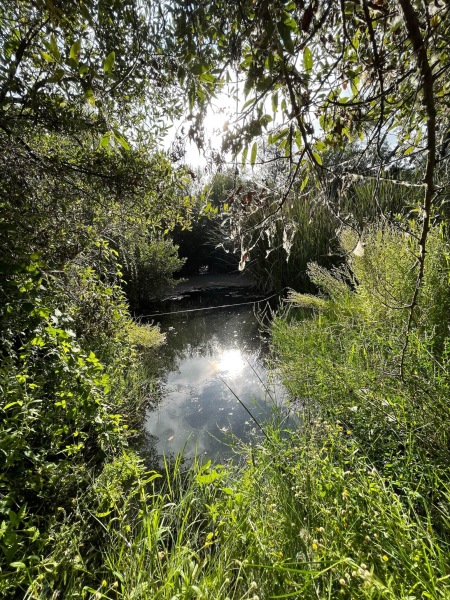If you’ve ever walked along Aliso Creek – whether from Aliso Creek Beach up to The Ranch or in the Aliso and Wood Canyon Wilderness Park on your way to Wood Canyon Trail – you might wonder what animal life depends on that creek for their very survival?
Well, among the coyotes, deer, Southwestern Pond Turtle and Egret, to name a few, there is a beautiful fish that can survive in both fresh and salt water, the Steelhead Trout.
When the native peoples, the Acjachemen, lived on this land, their main source of food was Coastal Live Oak acorns, supplemented with fish, like the Steelhead Trout.
In the past, our Southern California creeks and rivers looked very different than they do today and were more aligned with the natural season. This allowed fish, like the Steelhead Trout, to call this place their home. Nowadays, with an increase in urban runoff and more pollution into the creek, Steelhead Trout have been displaced from the Aliso Creek watershed.
Today, Southern California Steelhead Trout (Oncorhynchus mykiss irideus) is an endangered species of rainbow trout on the coast of Southern California. Scientists and conservationists are working hard to better understand the needs of this species and create conditions for their return.
The Steelhead Trout’s historical range is from the Tijuana River on the US-Mexico border all the way up to the Santa Maria River. There are three major factors that are causing the decline of this species: blocked access to historic spawning areas due to dams, inadequate stream flows due to urbanization and discharge of sediment and debris from human activities.
Steelhead Trout spawn from December through April in streams and tributaries where cool and well oxygenated water is available year-round. The female selects a site with good intergravel flow, then digs a redd, deposits eggs while an attendant male fertilizes them, and then covers them with gravel. An average of 550 to 1,300 eggs are deposited in each redd. Juveniles have a longer freshwater rearing requirement than the Pacific Salmon: 1-4 years in freshwater and 1-2 years in open ocean. Some Steelhead Trout can mature and spawn in freshwater without ever going to sea.

Southern California estuaries suffer from water pollution, filling from sediment creating uplands, invasive riparian and aquatic vegetation. While periodic wildfires are a part of the Southern California ecosystem they increase wet-season runoff, reduce summertime surface flows and increase stream temperatures. Non-native species include vegetation, fish, and amphibians. Invasive vegetation like Giant Redd (Arundo donax), Tamarisk (Tamirix ramosissima), and Pampas grass (Cortaderia selloana) disrupt river morphology creating monotypic riparian habitats that consume more water taking away from stream flow. Non-native species like smallmouth bass (Micropterus dolomieu) and bullfrogs (Lithobates catesbeianus) can prey upon juvenile Steelhead and compete for resources.
Restoration of streams and waterways within the historical range would be the best way to help the recovery of Southern California Steelhead Trout. Restoration techniques that increase habitat may include groundwater recharge projects, removal of barriers in watersheds with high quality habitat, removal of invasive species, and enhancement of instream and riparian habitats.
Today, Laguna Canyon Foundation continues its work in Aliso Creek to remove invasive plants, plant native plants and restore the habitat around the creek so that floral and fauna can survive and thrive. Next time you’re hiking or riding along Pecten Reef Loop and you see a few folks out there with snake-gators, tools and buckets, stop by to say hi. We’d love to chat with you.
Habitat criteria
- Depth
- Approximately 14 inches and ranges from 6-24 inches
- Fry prefer approximately 8 inches, utilize water 2-14 inches deep
- Parr prefer approximately. 10 inches, utilize water 10-20 inches deep
- Substrate
- Gravel size material is preferred for spawning but also use mixtures of sand-gravel and gravel-cobble size
- Fry and Parr prefer cobble-rubble size
- Temperature
- Adult: 46-52 F
- Spawning: 39-52 F
- Incubation and emergence: 48-52 F
- Fry and Parr: 45-60 F
- Smoltification: <57 F
- Low temps are not as much as a concern as high temps in Southern California
- They use aquatic vegetation, boulders, and wood as protective cover
